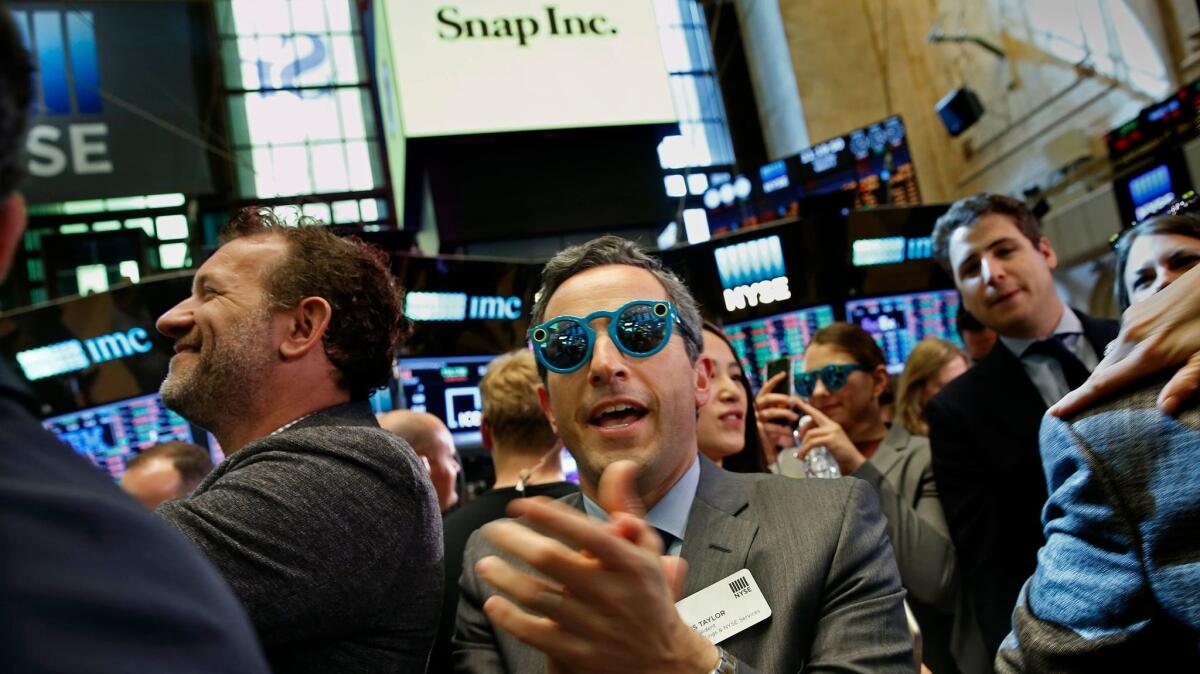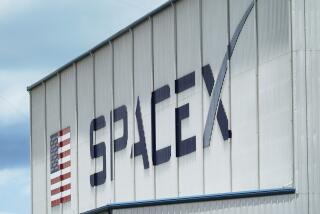Snap’s share price pops 44% in first day of public trading. Was price set too low?

- Share via
Snap Inc. shares closed at $24.48 in their first day of trading, a 44% jump over the price point the company and its underwriters set Wednesday afternoon.
Shares were priced Wednesday at $17 — that’s the price big institutional investors pay and that Snap Inc. receives. Thursday morning they opened on the New York Stock Exchange at $24 — the price at which new shareholders could opt to sell and prospective shareholders could choose to buy. Shares briefly topped $26 in afternoon trading.
The stock’s first-day gain is the kind of “pop” that’s typically cheered on Wall Street as evidence of strong investor demand for a newly public company. But it can also be evidence of something else: that the company and the investors who sold shares in the public offering left money on the table.
In the initial public offering, Snap sold 145 million new shares. At $17 apiece, that gives the company $2.47 billion in cash. Some of that will go to pay the investment banks that managed the IPO, but most will go to the company itself and be used to pay workers, make acquisitions and develop new products.
That’s a big sum, no doubt. But given Snap’s big pop and reports that Goldman Sachs, Morgan Stanley and the other investment banks running the offering had orders for 10 times as many shares as Snap was selling, it seems clear the company could have charged more than $17 a share.
Every additional dollar per share would have brought in another $145 million or so.
“With a 10-to-1 order book, they could have gone higher. Could they have priced at $18? Certainly,” said longtime investment banker Lloyd Greif of downtown L.A. firm Greif & Co., which was not involved in the offering.
There’s a point where pigs get fat and hogs get slaughtered. They erred on the cautious side. If you’re a smart issuer, you leave money on the table.
— Lloyd Greif, investment banker
But Greif also cautioned that pricing an IPO is “more art than science.” Had the company initially priced shares at $22 or $23 — still lower than Thursday’s close — he speculated that the market would have reacted much differently and the stock might have slumped.
“There’s a point where pigs get fat and hogs get slaughtered,” he said. “They erred on the cautious side. If you’re a smart issuer, you leave money on the table.”
Though raising money is one of the key reasons to go public, a company’s goal usually isn’t to maximize the proceeds from the first sale of stock. Companies and their investment banks also want good press — an IPO that pops makes for better headlines than one that slumps — and to curry favor with the big investment firms that buy shares at the initial price.
Setting the initial price too high and risking a first-day slump, or jacking up the price once it’s clear there’s lots of demand for the stock, could turn off investors, said Mark Mullen, a former investment banker and founder of West L.A. venture capital firm Double M Partners.
“You go out and do a roadshow and say, ‘We’re selling at $17, who wants in?’ You can’t just go back and say, ‘We’re actually raising it to $21,’” Mullen said. “I think it’s hard to figure out the right price, but this is an age-old argument.”
Though Snap Inc. gets no immediate benefit from Thursday’s pop, if the stock continues to trade above its IPO price it will mean a richer payday for the company’s founders, early investors and any employees that own Snap shares.
Those pre-IPO shareholders sold 55 million Snap shares, but held on to the vast majority of their holdings. Thursday’s pop boosts the value of their remaining shares, which nearly all investors will have to wait at least a few months to sell.
Follow me: @jrkoren
More to Read
Inside the business of entertainment
The Wide Shot brings you news, analysis and insights on everything from streaming wars to production — and what it all means for the future.
You may occasionally receive promotional content from the Los Angeles Times.











